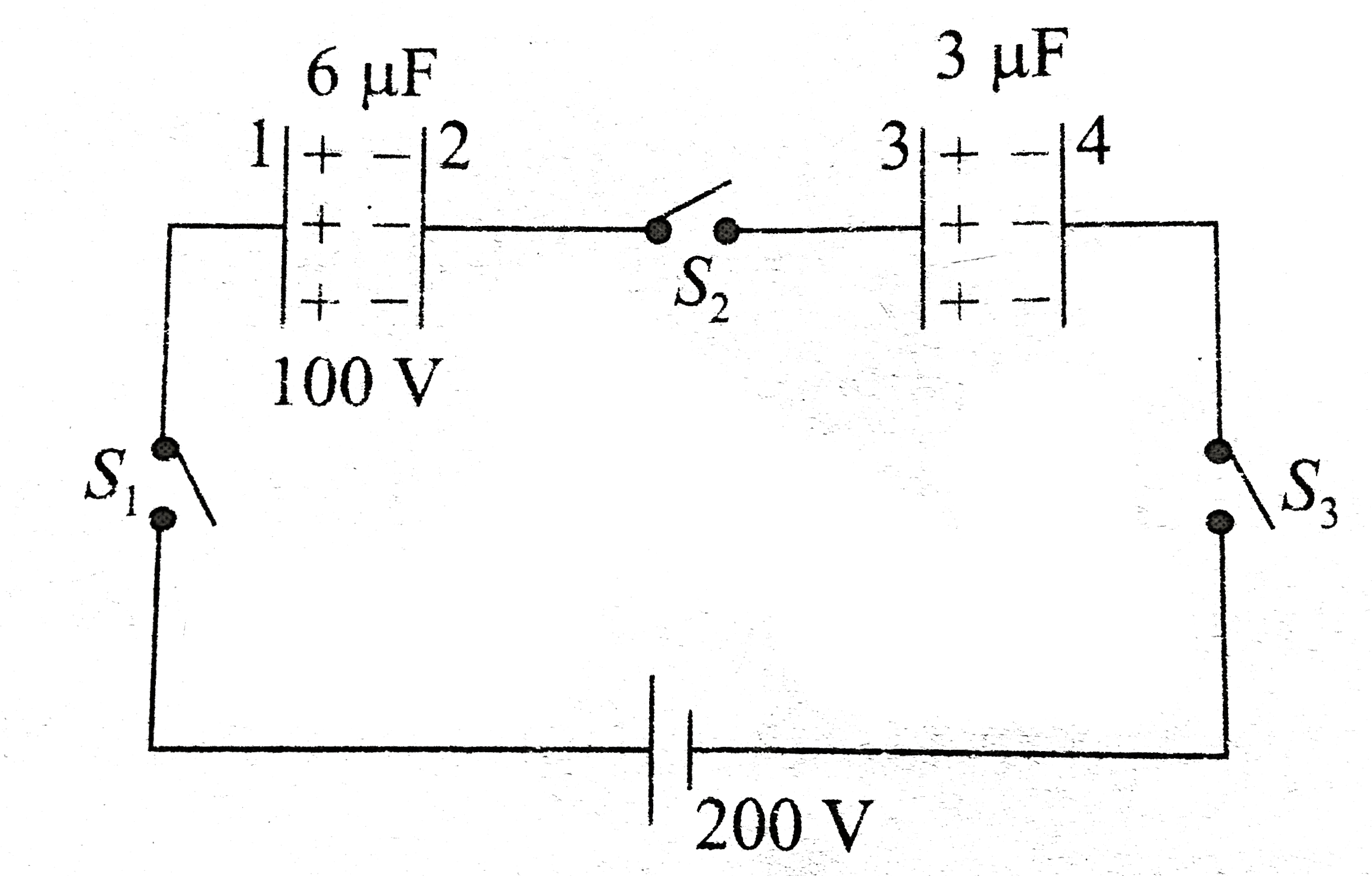Two capacitors of capacity 6μF and 3μF are charge 100V and 50V separately and connected as shown in Now all the three switches S1,S_(2) , and S_(3) are closed.

Which plates form an isolated system?
plate 1 and plate 4 separately
plate 2 and plate 3 separately
plates 1 and 4 jointly
plates 2 and 3 jointly
The correct Answer is:D
Step by step video & image solution for Two capacitors of capacity 6 muF and 3 muF are charge 100 V and 50 V separately and connected as shown in Now all the three switches S_(1),S_(2) , and S_(3) are closed. Which plates form an isolated system? by Physics experts to help you in doubts & scoring excellent marks in Class 11 exams.
Topper's Solved these Questions
- BOOK - DC PANDEY ENGLISHCHAPTER - ELECTROSTATICSEXERCISE - Matrix Matching2videos
ELECTROSTATICS
- BOOK - DC PANDEY ENGLISHCHAPTER - ELECTROSTATICSEXERCISE - Integer17videos
ELECTROSTATICS
- BOOK - DC PANDEY ENGLISHCHAPTER - ELECTROSTATICSEXERCISE - JEE Advanced44videos
ELECTROSTATICS
- BOOK - DC PANDEY ENGLISHCHAPTER - ELASTICITYEXERCISE - Medical entrances s gallery21videos
ELASTICITY
- BOOK - DC PANDEY ENGLISHCHAPTER - EXPERIMENTSEXERCISE - Subjective15videos
EXPERIMENTS
Similar Questions
(i) In an isolated system (neither connected to the terminal of a battery nor to any other source of charge e.g each) net charge remains constant.
(ii) From two terminal of a battery or from two plates of a capacitor equal and opposite charges enter or leave.
Question : Two capacitors of capacity 6μFand3μF are charged to 100 V and 50 V separatelly and connected as shown. Now all the three swiches S1S2andS3 are closed.

Which plate (s) form an isolated system .View SolutionTwo capacitors of capacity 6μF and 3μF are charge 100V and 50V separately and connected as shown in figure. Now all the three switches S1,S2, and S3 are closed.

Charge on the 3μF capacitor in steady state willl be.View Solution
Knowledge Check
- Question 1 - Select One
Two capacitors C1=2μF and C2=1μF are charged to same potential V=100V, but with opposite polarity as shown in the figure.
The switches S1 and S2 are closed. The ratio of final energy to the initial energy of the system is
 A1B12C19D14
A1B12C19D14
Two capacitors of capacity 6μF and 3μF are charge 100V and 50V separately and connected as shown in (Fig.4.201.) Now all the three switches S1,S2, and S3 are closed.

Charge on the 6μF capacitor in steady state will be.View SolutionTwo capacitros of capacity 6and3μF are charged to 100 V and 50 V separately and connected as shown. Now all the three switches S1,S2 and S3 are closed.

Charges on both the capacitors in steady state will be (on 6μF first)View SolutionTwo capacitros of capacity 6μF are charged to 100 V and 50 V separately and connected as shown. Now all the three switches S1,S2 and S3 are closed.

Suppose q1,q2 and q3 be the magnitudes of charge flown from switches S1,S2 and S3 after they closed. ThenView SolutionTwo capacitors C1=4μFandC2=2μF are charged to same potential V = 500 Volt, but with opposite polarity as shown in the figure. The switches S1andS2 are closed.
 View Solution
View SolutionTwo capacitors of capacitance 2μFand5μF are charged to a potential difference 100V and 50 V respectively and connected such that the positive plate of one capacitor is connected to the negative plate of the other capacitor after the switch is closed, the initial current in the circuit is 50 mA. the total resistance of the connecting wires is (in Ohm):
View SolutionTwo capacitors C1 and C2 are charged to same potential V, but with opposite polarity as shown in the figure. The switches S1 and S2 are then closed
 View Solution
View SolutionTwo capacitor each of capacitance C=1μF each charged to potential 100 V and 50 V respectively and connected across a uncharged capacitor 'C' = 1μF as shown in the figure if switch 'S' is closed then charge in the uncharged capacitor at equilibrium will be
 View Solution
View Solution

